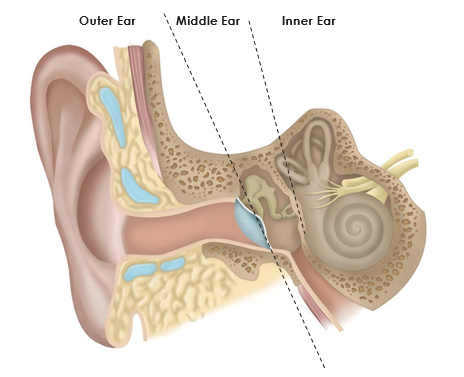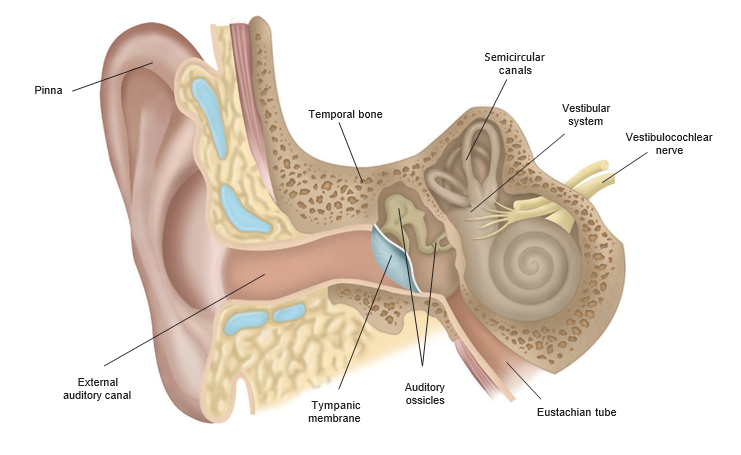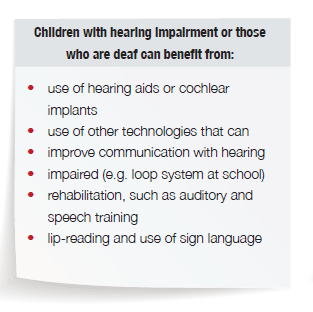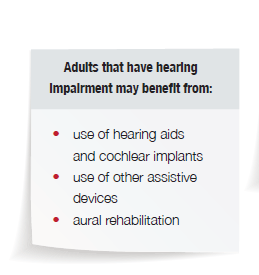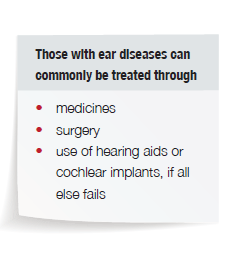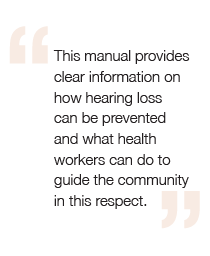Content begins here
Main page content
Click to collapse
LEARNING OBJECTIVES 
By the end of this module, you should be able to
• Explain why hearing is important
• Recognise and name parts of the ear
• Explain the function of the ear
• Explain the path sound travels through the ear
• Explain how people hear
TERMINOLOGY
| –– Audiologist –– Auditory nerve (hearing and balance nerves) –– Cochlea (hearing organ) –– Deaf –– Ear canal –– Ear drum (Tympanic Membrane) –– ENT surgeon –– Facial nerve –– Hair cells –– Hard of hearing –– Inner ear –– Levels of hearing loss: mild, moderate, moderate severe, severe, profound, complete, singlesided (unilateral) |
–– Middle Ear –– Middle ear space –– Ossicles - malleus, incus, stapes –– Outer Ear –– Pinna –– Sound Vibrations –– Speech therapist –– Tragus –– Teacher of the deaf –– Vestibular system (balance organ) –– Wax |
1.1 WHY DO WE NEED TO HEAR?
Hearing is important for communication at all ages and keeps us connected to others.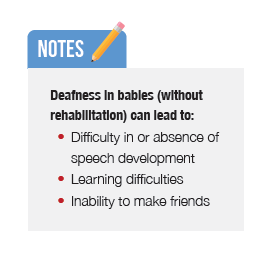
As babies, we develop speech by listening to other people talking and then try to imitate what they are saying. Hearing is crucial for developing speech. Babies who have severe hearing loss will find it difficult to speak languages. As a matter of fact, children born deaf or those who become deaf before they learn to speak cannot develop speech without special training. If their hearing impairment is not addressed in a timely manner, children would have difficulties in school and with friends. Besides this, communication and language is essential for proper brain development. If hearing impaired or deaf children do not receive timely intervention, this can affect their overall development.
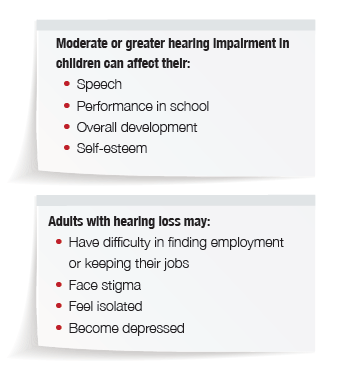
Because hearing is important to the way we communicate and hearing impairment is invisible, there is often stigma attached with the condition. People commonly form an incorrect opinion about someone who cant hear well. They may think that someone who is hard of hearing is not intelligent, which is wrong. In some places, deaf persons who do not develop spoken language are incorrectly referred to as ‘Deaf and dumb’. Such terms should not be used and such practices strongly discouraged.
Some children and adults have ear diseases, such as ear infections that come often, or never go away. They have pus coming from their ears. This can be embarrassing or make it difficult to be around other people. Rarely, ear infections can spread from the ear into the brain and cause serious, even life threatening complications.
Possibly 21,000 people in the world die
due to complications of ear infections, every year.
1.2 HOW DO WE HEAR?
Our ears help us hear. Ears collect sound vibrations and change them into electrical signals that are sent to the brain. The ears also help us to maintain balance.

The ear is in three parts: the outer ear, the middle ear, and the inner ear.
The part of the ear we can see on the outside is called the pinna. Sound vibrations from the air are picked up by the pinna and sent into the ear canal. The pinna and the ear canal together make the outer ear.
Once the sound has traveled down the ear canal, it moves the tympanic membrane (ear drum) and then the three ossicles (bones of hearing). The bones of hearing are called the malleus, incus, and stapes. They sit in a space called the middle ear, which is full of air. The movement of the ear drum and the bones of hearing makes the sound louder.
The bones of hearing conduct transmit sounds into the cochlea which is a shell-like structure in the inner ear. The cochlea is filled with fluid and sound vibrations move this fluid which in turn moves the thousands of hair cells present within the cochlea. This movement generates electrical signals in the hair cells. These electrical signals are carried by the auditory nerve to the brain. When these signals reach the brain, we hear the sound.
To have good hearing, all parts of the ear must be working properly. Joined to the cochlea is the vestibular system, which is the organ of balance. The liquid inside the vestibular system detects the position and movement of the body.
The cochlea and the vestibular system together make the inner ear.
Animation of sound transmission through the ear
1.3 WHAT IS HEARING IMPAIRMENT AND DEAFNESS?
People with hearing impairment are unable to hear as well as someone with n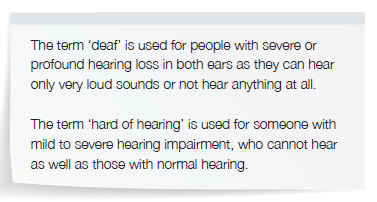
1.4 CLASSIFICATION OF HEARING LOSS
Hearing loss is classified according to severity or degree.
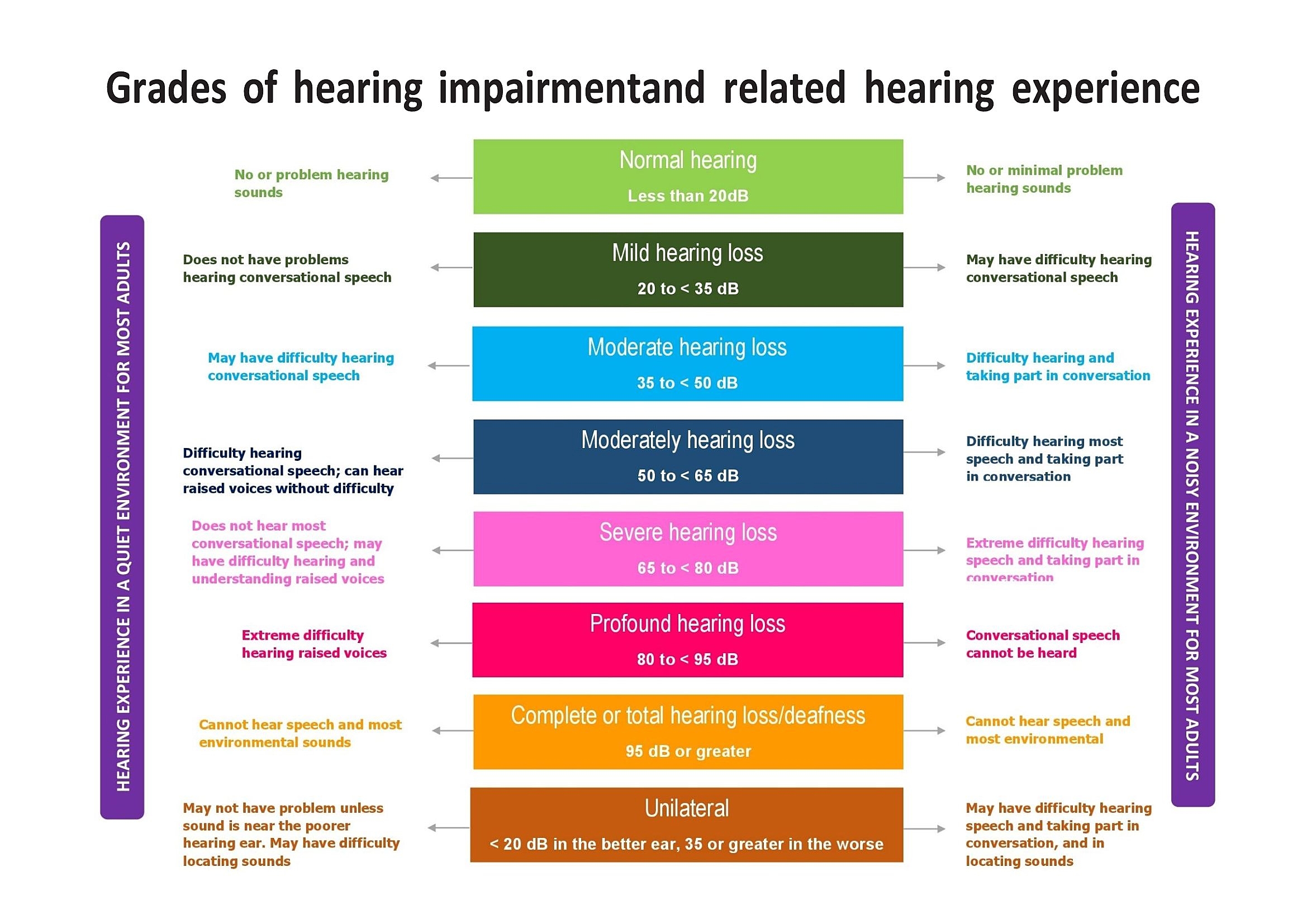
NOTES:
Despite the limitations of pure tone audiometry and a classi cation system based on it, the test provides a valid, reliable and repeatable measure for hearing assessment and classification. The primary use of this classification must be for purpose of data collection and analysis. Actual management of an individual and their rehabilitation requirements cannot be based solely on this audiometric hearing loss grade.
The above classification and grades are for epidemiological use and applicable to adults. The following points must be kept in mind while applying this classification:
- While audiometric descriptors (e.g., category, pure-tone average) provide a useful summary of an individual’s hearing thresholds, they should not be used as the sole determinant in the assessment of disability or the provision of intervention(s) including hearing aids or cochlear implants.
- The ability to detect pure tones using earphones in a quiet environment is not, in itself, a reliable indicator of hearing disability. Audiometric descriptors alone should not be used as the measure of difficulty experienced with communication in background noise, the primary complaint of individuals with hearing loss.
Hearing Loss Simulation
Your browser does not seem to have the necessary plugin to display this content. You may use the following link to download the contents as a file.
Hearing loss simulation.mp4
Contents are the legal property of House Ear Institute (HEI) or House Research Institute (HRI) and are used for educational purposes
1.5 HEARING IMPAIRMENT CAN BE ADDRESSED IF IDENTIFIED EARLY
Early diagnosis of ear diseases and hearing impairment is a crucial step in addressing this. Overall, it would not be wrong to say that nearly everyone who has an ear disease or hearing impairment would benefit from timely and appropriate actions. For example:
|
|
|
|
1.6 HEARING IMPAIRMENT AND DEAFNESS CAN BE PREVENTED:
It is estimated that in children 60% of hearing impairment can be prevented. Many small steps can help in this, including:
- Vaccination against rubella, measles, mumps, meningitis
- Ensuring that mothers and babies receive good care before, during and after birth
- Treating ear infections and other ear problems (e.g. wax)
- Protecting ears from loud sounds at work and in the environment
- Safe listening to prevent hearing impairment sue to loud music listening
- Asking a doctor if your medicine can affect your hearing and checking on how this can be avoided
- Taking good care of your ears by following healthy ear practices (refer module 9 for Dos and Don’ts)
Besides prevention, early identification and management of common ear problems and hearing loss; health workers can do a lot to support people with hearing loss and change the way the community perceives these problems.
1.7 WHO DIAGNOSES AND MANAGES EAR AND HEARING PROBLEMS?
Many different people can be involved in the diagnosis and treatment or rehabilitation of ear and hearing problems.
|
|
Ideally all would work together with the patient or family to address the hearing impairment or ear disease. In many countries there are not enough specialists in ear and hearing problems. In some countries there are no specialists at all.
|

